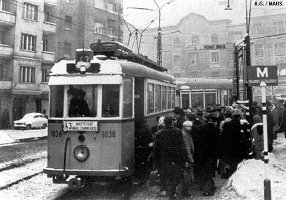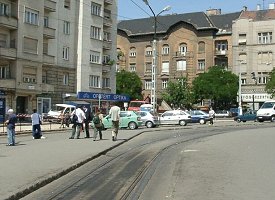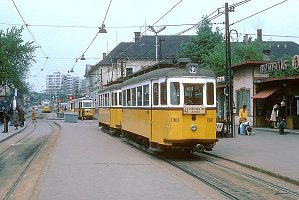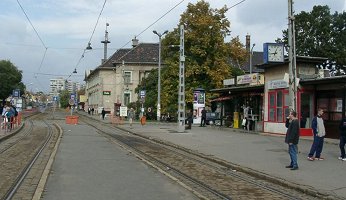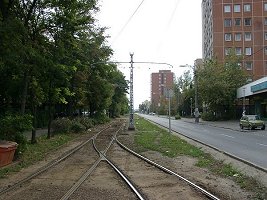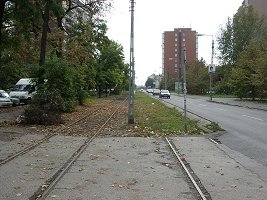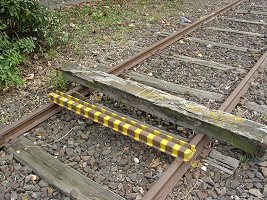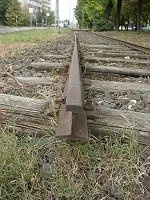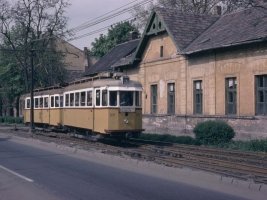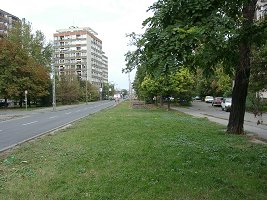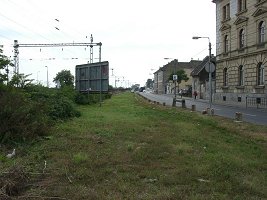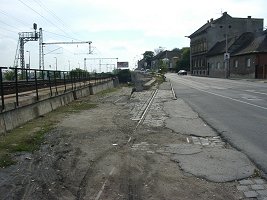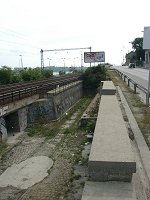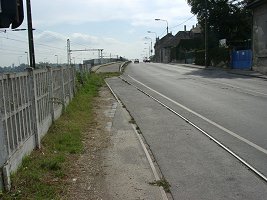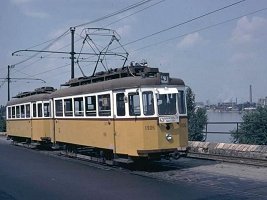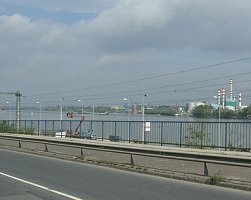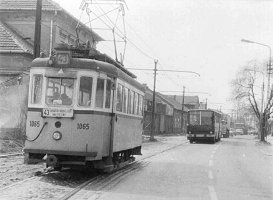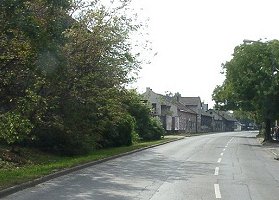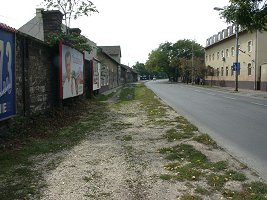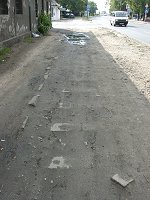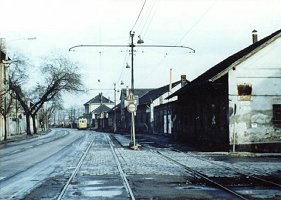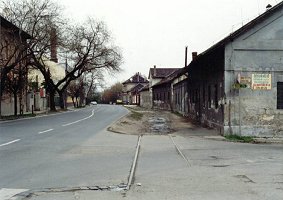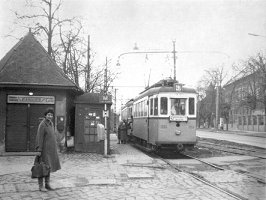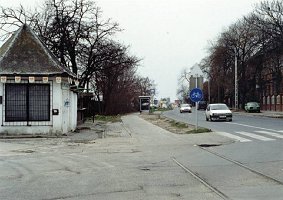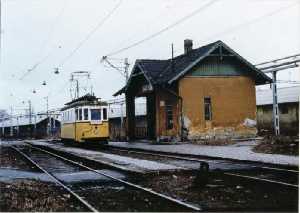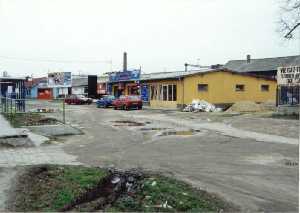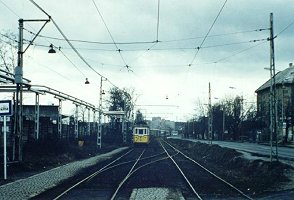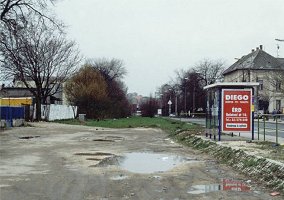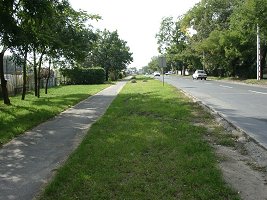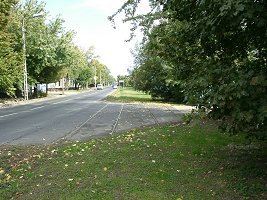budapest
other hungarian
close-up
lost rails
other countries
With photos from Friedrich Haselberger, Heinz Heider, Tim Boric, Rudolf Lakos, Gábor Szelényi and others
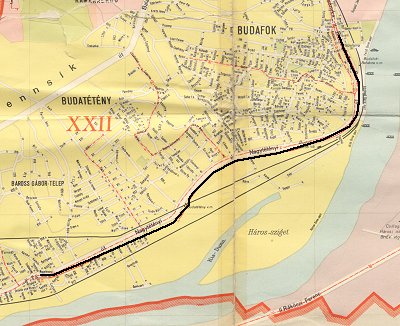 Let's
start with some childhood memories: the first time I went to Budatétény,
where this route went, was when one of my classmates organised a party.
On the way there I was surprised to see rails by the road: they were there
and then they were gone. They appeared again and then dissapeared. I was
baffled. The grandfather of my classmate saw this and told me that this
was once tram route 43, which was abandoned a few years earlier. Back
then I could not associate this memory with another from a couple of years
earlier, when I saw trams from the window of a train at Budafok.
Let's
start with some childhood memories: the first time I went to Budatétény,
where this route went, was when one of my classmates organised a party.
On the way there I was surprised to see rails by the road: they were there
and then they were gone. They appeared again and then dissapeared. I was
baffled. The grandfather of my classmate saw this and told me that this
was once tram route 43, which was abandoned a few years earlier. Back
then I could not associate this memory with another from a couple of years
earlier, when I saw trams from the window of a train at Budafok.
Now, after almost twenty years I'm even sadder about this "lost" route: it was a piece of urban transportation history! The tram route started its life as a HÉV (suburban railway) line in 1899 between Szent Gellért tér and Budafok-Háros operated by the company BBVV. At the inner section HÉV cars shared the tracks with BKVT trams, but they used a different overhead wire which they reached with a pole current collector. Ten years later the line was extended to Nagytétény, and the section between Móricz Zsigmond körtér and Budafok-Háros was rebuilt from one track to two. In 1911 BBVV was bought by BKVT and from that point the line was operated by BHÉV, a subsidiary of BKVT. New cars (mainly trailers) were also purchased, and a turning loop was built at Szent Gellért tér. Also, a new service was launched to Törökbálint (the remains of this side line is what we now know as tram route 41). After the 1st World War BHÉV was bought by the joint Budapest transportation company BSZKRT. But changes in the ownership were not the only odd characteristics to the route: on the technical front it was interesting that HÉV cars were using 1000V (later 1100V) while trams used 550V and they had to share the Fehérvári út tracks between Szent Gellért tér and the Budafok depot. To make this happen, this section was operated with 550V which made HÉV trains (which were bigger than a normal tram) quite slow. This remained a very serious problem (with trams queuing up behind HÉV trains) for decades!
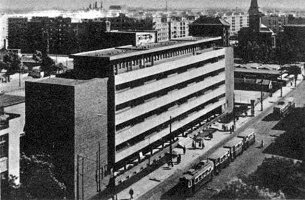 In
1942 the inner terminus was moved from Szent Gellért tér to Móricz
Zsigmond körtér, where a three-track turining loop was built. In
1951 BHÉV was incorporated to MÁV, the hungarian railways, but the Southern-Buda
routes were given to FVV, the Budapest tram company. And this was still
not everyting: in 1958 HÉV lines were given ("given" sounds strange, but
this wasn't a trade) back to the re-founded company BHÉV: the Nagytétény
and Törökbálint services too. This was the last big event of
this HÉV route: in 1962 these two lines were again given to FVV, and the
tram company turned them into regular tram routes. From the 1st of January,
1963 the Nagytétény HÉV service became route 43, while the Törökbálint
line was cut back to Budaörs and renamed to route 41.
In
1942 the inner terminus was moved from Szent Gellért tér to Móricz
Zsigmond körtér, where a three-track turining loop was built. In
1951 BHÉV was incorporated to MÁV, the hungarian railways, but the Southern-Buda
routes were given to FVV, the Budapest tram company. And this was still
not everyting: in 1958 HÉV lines were given ("given" sounds strange, but
this wasn't a trade) back to the re-founded company BHÉV: the Nagytétény
and Törökbálint services too. This was the last big event of
this HÉV route: in 1962 these two lines were again given to FVV, and the
tram company turned them into regular tram routes. From the 1st of January,
1963 the Nagytétény HÉV service became route 43, while the Törökbálint
line was cut back to Budaörs and renamed to route 41.
The lines were operated with 600V from this point and instead of the long HÉV trains smaller twin tram sets were launched. Of course this wasn't as simple as this: the 1900-series twin sets were built from 1000-series streetcars and similar (same chassis, same manufacturer) HÉV motorcars, but you cannot turn dozens of cars into twin sets in just one night! In the first months motor+trailer sets, which were unable to cope with the traffic, were operated here - many accidents happened when passengers fell off the overloaded cars.
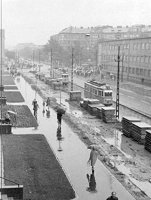 Besides
route 43 (Móricz Zsigmond körtér-Nagytétény) two sub-routes
were also launched: 43A (Móricz Zsigmond körtér-Budatétény
Kultúrpark) and 43B (Móricz Zsigmond körtér-Baross Gábor
telep). The latter was stopped in 1968. In the last days of 1972
the whole of Budapest's public transportation was reshuffled: just think
of the closure of tram traffic on Rákóczi út, which had a great
inpact on everything else too. For example route 4 (which run from Budafok,
Varga Jenő tér) was cut back to Fehérvári úti lakótelep,
while route 47 (which run to Budafok depot) was extended to Budafok,
Varga Jenő tér. Route 41 was cut back to Budafok depot,
route 43 to Varga Jenő tér, while route 18 (originally: Kelenföld
railway station) was extended to Albertfalva kitérő and route
9 (originally: Albertfalva kitérő) was extended to Varga
Jenő tér. What a mess! Of course the most important change from our
current viewpoint was the fact that route 43 did not go to Móricz
Zsigmond körtér anymore, but to Varga Jenő tér, which is
quite out in the skirts itself. This led to loss of passengers: bus line
3 was better than the tram: it go all the way to Móricz Zsigmond körtér,
you were not forced to change. Only night route 43É (Móricz Zsigmond
körtér-Nagytétény) remained...
Besides
route 43 (Móricz Zsigmond körtér-Nagytétény) two sub-routes
were also launched: 43A (Móricz Zsigmond körtér-Budatétény
Kultúrpark) and 43B (Móricz Zsigmond körtér-Baross Gábor
telep). The latter was stopped in 1968. In the last days of 1972
the whole of Budapest's public transportation was reshuffled: just think
of the closure of tram traffic on Rákóczi út, which had a great
inpact on everything else too. For example route 4 (which run from Budafok,
Varga Jenő tér) was cut back to Fehérvári úti lakótelep,
while route 47 (which run to Budafok depot) was extended to Budafok,
Varga Jenő tér. Route 41 was cut back to Budafok depot,
route 43 to Varga Jenő tér, while route 18 (originally: Kelenföld
railway station) was extended to Albertfalva kitérő and route
9 (originally: Albertfalva kitérő) was extended to Varga
Jenő tér. What a mess! Of course the most important change from our
current viewpoint was the fact that route 43 did not go to Móricz
Zsigmond körtér anymore, but to Varga Jenő tér, which is
quite out in the skirts itself. This led to loss of passengers: bus line
3 was better than the tram: it go all the way to Móricz Zsigmond körtér,
you were not forced to change. Only night route 43É (Móricz Zsigmond
körtér-Nagytétény) remained...
This was of course the start of a slow dying for this tram route: the tracks and the cars were old. This made the line even slower, which then made more and more passengers switch to the bus. In the early eighties the 1900-series twins were relocated to Újpest, instead of them single 1000-series cars were operating the line. And then, from the 1st of December, 1983., route 43 is "paused". "Paused" of course is just a mild was of saying "abandoned". BKV, the Budapest transportation company never wanted to re-launch traffic here: one-track lines (like route 8 or 51) were all closed in those years. The money, from which these lines could have been rebuilt (new tracks, new vehicles) were fed into the construction of the underground railway line M3. The tracks of route 43 however remained partly unharmed: they were usable between Varga Jenő (now: Városháza) tér and Budafok-Háros until the mid-nineties! Then - nobody knows why - tracks and overhead were suddenly hauled away.
Remark: This "then and now" session also includes "now photos" taken in 2000 by Gábor Szelényi.
A motor+trailer set in the turning loop at Móricz Zsigmond körtér.
After 31. December, 1972 the inner terminus was relocated to Varga Jenő (now Városház) tér. Route 47 still has its terminus here...
... while one of the tracks that belonged to route 43 is now used for reversing and for reserve.
The end of the line.
To the left: a 1900-series twin leaving the terminus for Nagytétény. To the right: the location of the tracks can still be seen.
At Tóth József utca trams went up a slope...
... but there was also another pair of rails leading to a loading platform of a champagne factory (winery?) below the slope. To the right: this is a very narrow place, so only one of the tracks was separated, the other ran on the road with cars coming directly opposite! Only bits of the separated track have remained.
On the other side of the Danube you can see Csepel island.
The road remained narrow for a few hundred meters, and this was a very dangerous traffic situation: as you can see on the photo to the left, the 1000-series tram and the bus coming from the opposite direction share the same road-space. One of the official reasons why route 43 was closed was this.
You can see remains of the tracks in the mud here!
Tram stop Vágóhíd utca. From this point Nagytétényi út becomes broader...
... and there is space for both tracks being separated from the road.
The stop at József Attila utca, this is where the HÉV had its first terminus in 1899.
Looking to the other direction.
After József Attila utca, the location of the tracks has been recultivated, but you can still see lost rails here and there!
Next page: from Budatétény Kultúrpark to Nagytétény
Archive photos and maps: Friedrich Haselberger, Heinz
Heider, Tim Boric, Rudolf Lakos, Gábor Szelényi, plus teh collection of
Zoltán Ádám Németh, Mr. Cyber and the author
Special thanks to Csaba Adamecz!
Back to the top Back to the main page
